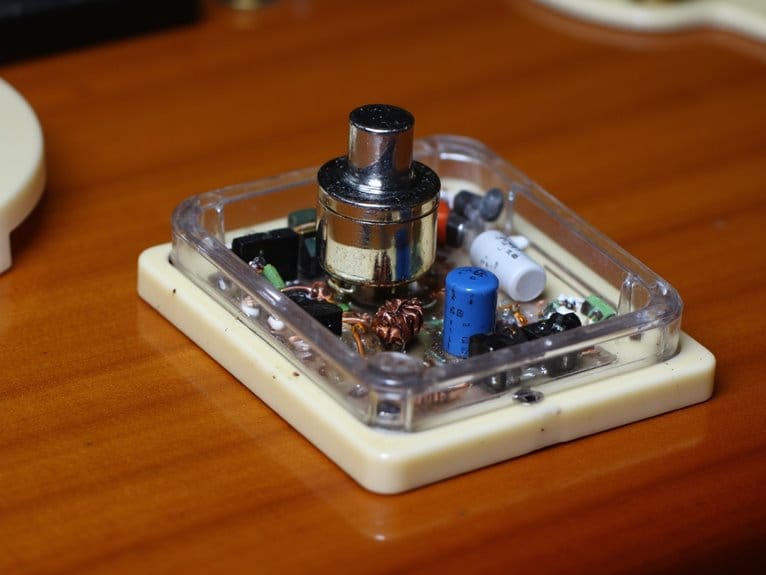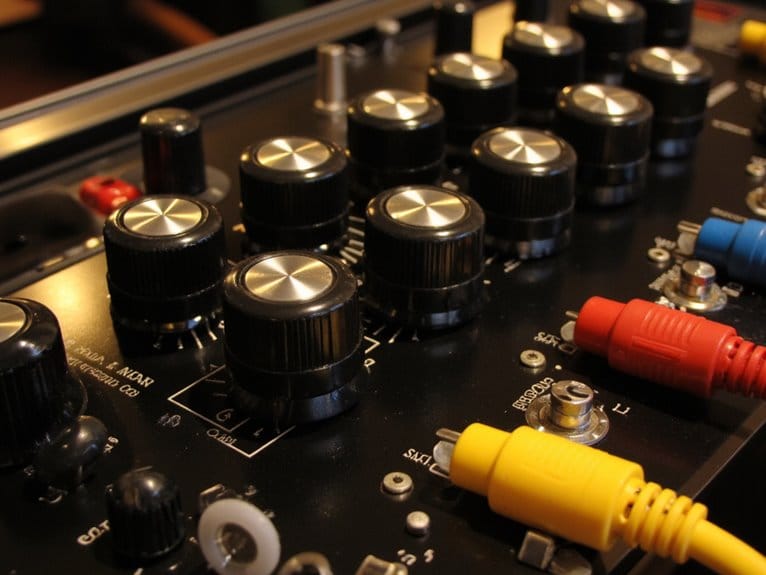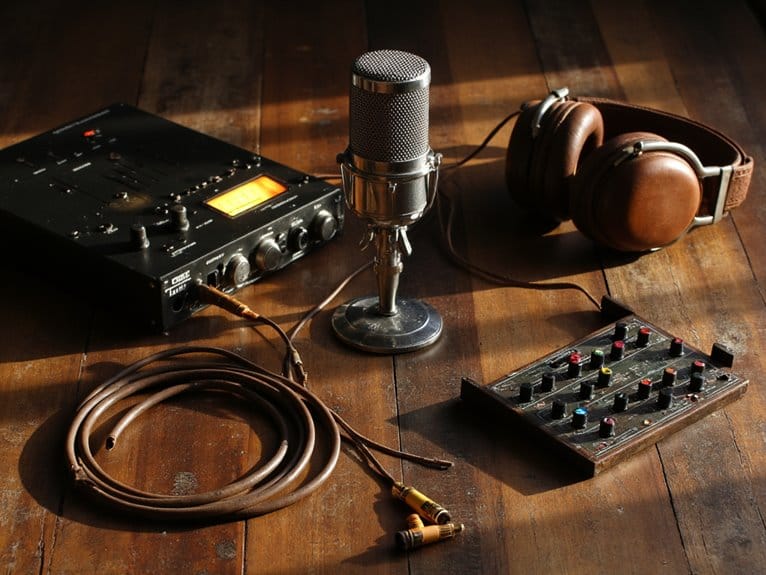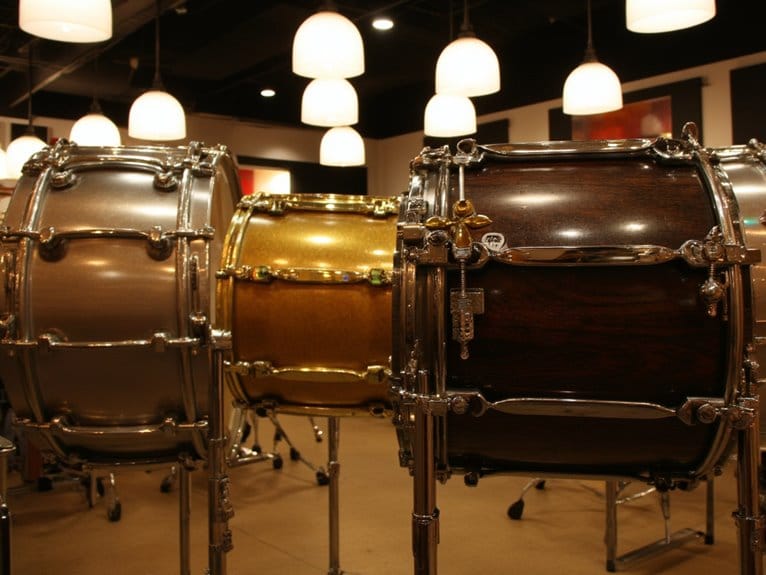Understanding Guitar Impedance and Buffering
Guitar impedance, measured in ohms, determines how your pickup’s electrical signal travels to your amplifier, with most pickups ranging from 470kΩ to over 1MΩ. High impedance outputs deliver higher voltage but suffer signal degradation over long cable runs, causing treble roll-off that robs your tone’s brightness and clarity. Proper impedance matching requires your amp’s input to be at least 10 times your pickup’s impedance, while strategic buffer placement throughout your pedal chain preserves signal integrity and maintains your guitar’s natural frequency response for ideal sound quality.
We are supported by our audience. When you purchase through links on our site, we may earn an affiliate commission, at no extra cost for you. Learn more.
Notable Insights
- Guitar pickups have high impedance (470kΩ-1MΩ+) requiring proper matching to prevent signal loss and treble roll-off.
- High impedance signals degrade over long cable runs due to capacitance effects that filter high frequencies.
- Buffers convert high impedance guitar signals to low impedance, preserving tone clarity through longer cables and pedal chains.
- Op-amp buffers provide transparent response while FET buffers add warmer, organic tonal coloration for different musical styles.
- Strategic buffer placement at input, mid-chain, or output positions optimizes signal integrity throughout complex pedalboard setups.
What Is Guitar Impedance and Why Does It Matter?
When I first started diving deep into guitar electronics, I’ll admit that impedance seemed like one of those intimidating technical concepts that only circuit engineers needed to worry about, but it’s actually fundamental to understanding why your guitar sounds the way it does.
Think of impedance as electrical resistance that changes depending on frequency, measured in ohms, affecting how your signal travels from pickups to amplifier.
Impedance acts like frequency-dependent electrical resistance, measured in ohms, controlling how your guitar signal flows to your amplifier.
Different pickup types generate varying impedance levels, typically ranging from 470kΩ to over 1MΩ, which directly influences your tone’s character and clarity.
This matters because improper impedance matching between your guitar and amp can cause signal loss, treble roll-off, and that frustrating muffled sound that kills your guitar design’s intended voice. The complexity increases significantly when you introduce multiple pedals into your signal chain, as each connection adds resistance that can further diminish your tone’s clarity and high-frequency content. Additionally, long cable runs should be avoided as they create unwanted capacitance that forms a natural low-pass filter, progressively cutting high frequencies and dulling your guitar’s sparkle.
High Impedance Vs Low Impedance: the Key Differences
When you’re comparing high and low impedance signals, you’ll notice that high impedance outputs from your guitar pickups deliver higher voltage with less current, creating what I’d describe as a “gentle push” that’s sensitive to cable length and easily influenced by whatever equipment follows in your signal chain.
Low impedance signals, on the other hand, provide more current with that “strong push” characteristic, allowing them to drive through longer cables, multiple effects pedals, and complex setups without losing their strength or tonal integrity. However, longer high impedance lines face increased capacitance effects that can alter your guitar’s frequency response and affect the brightness and clarity of your tone.
These fundamental differences in signal strength directly impact how your guitar’s tone translates through your entire rig, from the initial pickup output to your amplifier’s input, making impedance matching essential for preserving the sound you’re after. Understanding impedance becomes particularly important when choosing small guitar amps that need to properly match with your guitar’s output for optimal sound quality and performance.
Signal Strength Characteristics
Although guitar impedance might seem like an abstract electrical concept, the signal strength differences between high and low impedance systems create very real, audible effects that’ll directly impact your tone and performance setup. Understanding how electrical resistance affects signal transmission becomes vital when you’re dealing with complex pedalboards or long cable runs.
| Characteristic | High Impedance | Low Impedance |
|---|---|---|
| Voltage Output | Higher voltage, less current | Lower voltage, higher current |
| Cable Length Tolerance | Poor – degrades quickly | Excellent – maintains strength |
| Frequency Response | Prone to treble roll-off | Preserves full spectrum |
| Noise Susceptibility | More vulnerable to interference | Better noise rejection |
| Drive Capability | Limited pushing power | Strong signal drive |
High impedance sources output stronger voltage but lack the current needed for consistent signal transmission over distance.
Tone Quality Impact
The moment you plug your guitar into different impedance systems, you’ll notice immediate tonal differences that can make or break your sound. I’ve learned through years of testing gear that these changes aren’t subtle suggestions—they’re dramatic shifts in your instrument’s voice.
High impedance signals suffer from capacitance effects that rob tone brightness, particularly when you’re using longer cables or cheaper cabling choices that introduce signal degradation.
Your treble preservation depends on three critical factors:
- Load impedance must be at least 10 times your pickup’s source impedance for sustain maintenance
- Cable capacitance acts like a high-frequency filter, stealing sparkle from your sound
- Amplifier compatibility requires proper impedance matching to maintain natural frequency response
Poor impedance management transforms crisp, articulate tones into muddy approximations of your guitar’s true voice. Just as spruce tops deliver bright and articulate acoustic tones, proper impedance matching preserves the natural brightness and clarity of your electric guitar’s signal chain.
How Impedance Affects Your Guitar Tone and Sound Quality
Every guitarist has experienced that moment when their carefully crafted tone suddenly sounds muddy, dull, or lifeless.
While you might blame your amp settings or blame a dying battery in your favorite overdrive pedal, the real culprit is often lurking in the invisible world of electrical impedance. Your guitar’s high-impedance output signal becomes vulnerable to signal degradation when it encounters mismatched loads, particularly gear with input impedance below 100kΩ.
This shunts precious signal to ground and robs your tone of brightness and sustain. Proper impedance matching preserves those crisp highs and detailed nuances that make your playing shine, while mismatched connections create a sonic filter that gradually drains life from your signal.
The Electrical Principles Behind Guitar Signal Transfer
When your guitar signal travels from pickup to amplifier, it follows fundamental electrical principles that directly impact what you hear, with Ohm’s Law governing the relationship between voltage, current, and resistance throughout your entire signal chain.
Your guitar’s AC signal contains reactive components that behave differently than simple DC circuits, creating frequency-dependent impedance changes that shape your tone in ways you mightn’t expect.
Understanding these electrical principles, particularly how inductance and capacitance affect your signal’s reactance, will help you make informed decisions about your gear and optimize your sound quality.
Ohm’s Law Guitar Applications
Understanding electrical principles might sound intimidating, but I’ve found that Ohm’s Law serves as the foundation for virtually every aspect of guitar signal transfer, from pickup output to amplifier input.
When you’re dealing with different resistances in your signal chain, you’ll notice how impedance interactions directly affect your tone and volume levels.
Here’s what you need to know about Ohm’s Law applications:
- Cable resistance calculations help you determine signal loss over long runs, preventing unexpected tone degradation during performances.
- Pickup impedance matching guarantees your high-output pickups don’t get loaded down by low-impedance inputs, preserving clarity and dynamics.
- Voltage drop predictions across connectors and cables allow you to choose appropriate gear configurations for the best signal integrity.
These calculations aren’t just academic exercises—they’re practical tools for maintaining consistent, professional sound quality. Just like audio interfaces require adequate preamp gain to handle low-output dynamic microphones effectively, guitar signal chains need proper impedance matching to preserve signal strength. Many modern audio interfaces provide instrument inputs specifically designed to accommodate guitars and bass, preventing clipping while maintaining proper impedance relationships. Quality oxygen-free copper conductors in your cables minimize resistance and signal degradation, ensuring your electrical calculations translate into real-world performance improvements.
AC Signal Reactance Components
The complexity of guitar signal transfer goes far beyond simple resistance calculations, diving into the domain of reactance where capacitors and inductors create frequency-dependent impedance that shapes your tone in ways you mightn’t expect.
Your pickups contain wire coils that produce inductive reactance, which increases with frequency and creates that characteristic resonance peak when combined with stray capacitances.
Meanwhile, capacitance effects from your cables and coupling capacitors decrease reactance as frequencies rise, allowing treble to pass more easily while rolling off bass response.
This inductance influence from your pickups, combined with cable capacitance, determines your guitar’s resonant frequency and overall tonal coloration, making reactive components just as essential as simple resistance in defining your sound.
Buffering Solutions for Maintaining Signal Integrity
Every guitarist I’ve encountered battles the same invisible enemy—signal degradation that slowly robs your tone of its clarity and punch as it travels through cables and pedals.
Understanding buffer types becomes essential when you’re dealing with long cable runs or multiple true bypass pedals that create impedance mismatches.
Long cable runs and multiple true bypass pedals create impedance mismatches that demand strategic buffer placement for optimal signal integrity.
Strategic buffer placement solves these problems through three key approaches:
- Input buffering at your pedalboard’s start converts your guitar’s high-impedance signal to low-impedance.
- Mid-chain buffering after sensitive effects like fuzz pedals maintains proper signal loading.
- Output buffering before your amplifier restores signal strength after long cable runs.
Op-amp buffers provide transparent, linear frequency response, while FET buffers offer warmer, more organic coloration with subtle compression that many players prefer for blues and vintage tones.
Professional audio interfaces often incorporate high-performing preamps with switchable modes that can enhance signal clarity, making them valuable tools for guitarists recording their buffered signal chains. Many guitarists recording at home benefit from interfaces with zero-latency monitoring to hear their direct input signal without delay during the recording process. Some advanced interfaces feature high-headroom instrument inputs that prevent clipping even with hot guitar signals, ensuring clean capture of your buffered tone.
Optimizing Your Pedal Chain Through Impedance Management
While buffering provides the foundation for signal integrity, I’ve learned that proper pedal chain organization requires a deeper understanding of how each component’s impedance characteristics interact with your entire signal path.
Smart pedal placement becomes essential when you’re managing multiple effects, as placing low input impedance pedals like wahs early in your chain can dramatically load down your guitar’s signal.
I’ve found that strategic buffer placement before long cable runs, combined with high-quality shielded cables featuring lower capacitance ratings, preserves those vital high frequencies that define your tone’s clarity.
Cable quality matters more than most players realize, particularly when you’re running extensive pedalboards where each connection point introduces potential impedance mismatches that accumulate throughout your signal chain.
Professional preamps with Buffer Bypass Circuit technology maintain your original tone’s integrity when the effect is disengaged, preventing signal degradation that commonly occurs with poorly designed pedal interfaces.
Common Impedance Problems and How to Solve Them
How does a perfectly functioning pedalboard suddenly transform into a tone-sucking nightmare when you add just one more effect? I’ve witnessed this scenario countless times, and it’s usually an impedance matching problem creating signal degradation throughout your chain.
Here’s what typically goes wrong:
- High-frequency loss occurs when your piezo pickup meets a low-impedance pedal input, causing that dull, lifeless tone you’re desperately trying to fix.
- Volume drops happen when impedance mismatches prevent proper voltage transfer between your guitar and first pedal.
- Increased noise creeps in through long cable runs with high-impedance sources hitting inappropriate input stages.
The solution involves strategic buffer placement and understanding your pickup’s impedance requirements.
Piezo pickups need at least 1 megohom input impedance, while passive magnetic pickups require inputs 7-10 times higher than their output impedance for peak performance. Just as impedance matching is crucial for guitar signals, proper microphone impedance matching ensures optimal signal transfer in professional audio recording setups.
Frequently Asked Questions
Can I Use Multiple Buffers in My Pedal Chain Without Negative Effects?
You can use multiple buffers with multiple pedals, but excessive buffering causes cumulative signal drop and tonal changes. Different buffer types affect your chain differently, so strategically place one at the beginning and end for best results.
Should I Worry About Impedance When Recording Direct Into Audio Interfaces?
You should worry about impedance when direct recording into audio interfaces. Use Hi-Z inputs or DI boxes to prevent dull, muffled tone. Impedance mismatch won’t damage gear but greatly degrades sound quality.
How Does Pickup Height Adjustment Relate to Impedance and Signal Strength?
Pickup position directly affects signal strength without changing impedance. You’ll get stronger output when closer to strings, improving signal clarity and reducing noise floor, but won’t alter your pickup’s electrical impedance characteristics.
Can Impedance Mismatches Permanently Damage My Guitar Pickups or Pedals?
Impedance mismatches won’t permanently damage your guitar pickups or most pedals due to their robust pickup design. You’ll experience signal degradation and tone loss, but the components themselves remain physically intact and functional.
On a final note
You’ve now got the knowledge to tackle impedance issues that’ll inevitably crop up in your signal chain, and honestly, understanding these electrical fundamentals puts you ahead of most guitarists who just plug in and hope for the best. Whether you’re dealing with high-impedance pickups losing sparkle through long cable runs, or managing multiple pedals that create loading issues, proper buffering and impedance matching will keep your tone intact and your signal strong.







